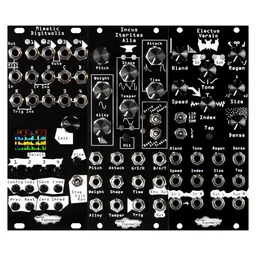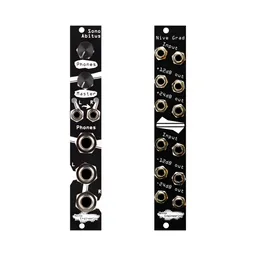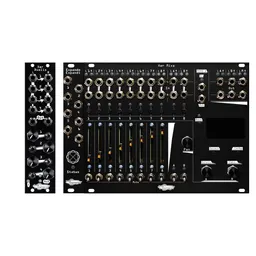Today, we continue the Getting Started series with another interesting synthesis technique: ring modulation. Ring modulation has some similarities to FM in that it uses two interacting oscillators to create a unique sound. However, in ring-modulation patches, one oscillator modulates the pitch of a carrier oscillator, creating what are called sidebands. The original two pitches of the oscillators are not heard in the output, but the sidebands are a function of those two frequencies.
Ring modulation is one of my personal favorite synthesis techniques, too, as it sounds great and it’s quite easy to patch in Eurorack, but is rarely implemented in software and fixed-architecture synthesizers.
Patching ring modulation
Ring-modulator modules are generally quite simple: they’ll have two inputs for modulator and carrier (the oscillator modulating the signal and the oscillator being modulated, respectively), and an audio output.
Many ring-modulator modules are passive and simply feature inputs and outputs with no level controls. It can be useful to patch up an attenuator before the modulator input to control the amount of modulation, as this has a big impact on the timbre of the sound.

There are a few ways to change the timbre of a ring-modulation patch. Along with changing the level (or shape) of the modulator wave, changing the pitches of the two oscillators will drastically change the sound you create. Starting with sine waves is a nice way to keep your sounds clean, but using different waveforms will also make a big difference in the timbre of your patch.
Differences between ring modulation and amplitude modulation
Ring and amplitude modulation can sound similar at first glance, in part because ring modulation is a form of amplitude modulation. People often ask about the difference between the two. Both can create metallic, from brash to bell-like sounds, but ring modulation is perhaps a bit more unpredictable?
The main difference is how the oscillators impact the output: with RM, the sidebands are the only thing that the circuit will pass to the output. With AM, the carrier frequency comes through in the output along with the sidebands.
For example, if your carrier frequency is 500 Hz, and your modulator frequency is 100 Hz, then with RM, your output will be 400 and 600 Hz. Since AM includes the carrier frequency AND sidebands, then the same input to AM will include 400, 500, and 600 Hz.
These techniques are not set up to care about harmonic relationships, so both AM and RM can give you some sounds that are unique and interesting, but perhaps not what you might expect. Give yourself some time to learn how to tame them!
Applications
Along with just being a cool patching technique for metallic sounds, ring modulators have a variety of practical applications. A technique called heterodyning is a way to use multiple modulators to perform frequency shifting. These show up in our synth modules sometimes in frequency shifter and other types of modules. And while these are cool, heterodyning is also used in a variety of communication technologies like radio, cable TV, laser spectroscopy, astronomy, and more. In fact, amplitude modulation was developed primarily to aid in the transmission of radio waves!
Choosing a ring modulator
As with anything in modular, different ring modulators will have slightly different timbres and layouts. Ring modulators have a variety of different formats: some of them, like the ADDAC below, are even passive!
ADDAC602: A passive transformer-based dual ring modulator.
Random Source Ring: A characterful Serge-inspired ring modulator with a few other utilities.
Doepfer A-114: A simple dual ring modulator.






